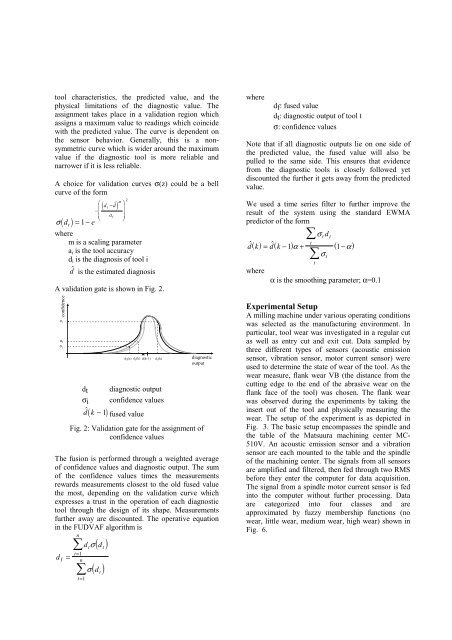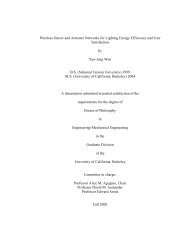Diagnostic Information Fusion for Manufacturing Processes
Diagnostic Information Fusion for Manufacturing Processes
Diagnostic Information Fusion for Manufacturing Processes
Create successful ePaper yourself
Turn your PDF publications into a flip-book with our unique Google optimized e-Paper software.
tool characteristics, the predicted value, and the<br />
physical limitations of the diagnostic value. The<br />
assignment takes place in a validation region which<br />
assigns a maximum value to readings which coincide<br />
with the predicted value. The curve is dependent on<br />
the sensor behavior. Generally, this is a nonsymmetric<br />
curve which is wider around the maximum<br />
value if the diagnostic tool is more reliable and<br />
narrower if it is less reliable.<br />
A choice <strong>for</strong> validation curves σ(z) could be a bell<br />
curve of the <strong>for</strong>m<br />
( )<br />
σ d<br />
t<br />
= 1−<br />
e<br />
<br />
<br />
−<br />
<br />
<br />
( dt<br />
−d<br />
)<br />
at<br />
m<br />
2<br />
<br />
<br />
<br />
<br />
<br />
where<br />
m is a scaling parameter<br />
a i is the tool accuracy<br />
d i is the diagnosis of tool i<br />
d is the estimated diagnosis<br />
A validation gate is shown in Fig. 2.<br />
confidence<br />
σ 1<br />
σ 3<br />
σ 2<br />
d 2 (k) d 3 (k)<br />
d(k-1)<br />
d 1 (k)<br />
dt diagnostic output<br />
σi confidence values<br />
d ( k − 1)<br />
fused value<br />
diagnostic<br />
output<br />
Fig. 2: Validation gate <strong>for</strong> the assignment of<br />
confidence values<br />
The fusion is per<strong>for</strong>med through a weighted average<br />
of confidence values and diagnostic output. The sum<br />
of the confidence values times the measurements<br />
rewards measurements closest to the old fused value<br />
the most, depending on the validation curve which<br />
expresses a trust in the operation of each diagnostic<br />
tool through the design of its shape. Measurements<br />
further away are discounted. The operative equation<br />
in the FUDVAF algorithm is<br />
d<br />
n<br />
<br />
d σ<br />
t<br />
t<br />
f = = 1<br />
n<br />
<br />
t=<br />
1<br />
σ<br />
( d )<br />
t<br />
( d )<br />
t<br />
where<br />
df: fused value<br />
dt: diagnostic output of tool t<br />
σ: confidence values<br />
Note that if all diagnostic outputs lie on one side of<br />
the predicted value, the fused value will also be<br />
pulled to the same side. This ensures that evidence<br />
from the diagnostic tools is closely followed yet<br />
discounted the further it gets away from the predicted<br />
value.<br />
We used a time series filter to further improve the<br />
result of the system using the standard EWMA<br />
predictor of the <strong>for</strong>m<br />
<br />
σ t d t<br />
d<br />
( k) d<br />
t<br />
= ( k − 1) α + ( 1−α<br />
)<br />
σ<br />
where<br />
<br />
t<br />
α is the smoothing parameter; α=0.1<br />
t<br />
Experimental Setup<br />
A milling machine under various operating conditions<br />
was selected as the manufacturing environment. In<br />
particular, tool wear was investigated in a regular cut<br />
as well as entry cut and exit cut. Data sampled by<br />
three different types of sensors (acoustic emission<br />
sensor, vibration sensor, motor current sensor) were<br />
used to determine the state of wear of the tool. As the<br />
wear measure, flank wear VB (the distance from the<br />
cutting edge to the end of the abrasive wear on the<br />
flank face of the tool) was chosen. The flank wear<br />
was observed during the experiments by taking the<br />
insert out of the tool and physically measuring the<br />
wear. The setup of the experiment is as depicted in<br />
Fig. 3. The basic setup encompasses the spindle and<br />
the table of the Matsuura machining center MC-<br />
510V. An acoustic emission sensor and a vibration<br />
sensor are each mounted to the table and the spindle<br />
of the machining center. The signals from all sensors<br />
are amplified and filtered, then fed through two RMS<br />
be<strong>for</strong>e they enter the computer <strong>for</strong> data acquisition.<br />
The signal from a spindle motor current sensor is fed<br />
into the computer without further processing. Data<br />
are categorized into four classes and are<br />
approximated by fuzzy membership functions (no<br />
wear, little wear, medium wear, high wear) shown in<br />
Fig. 6.
















